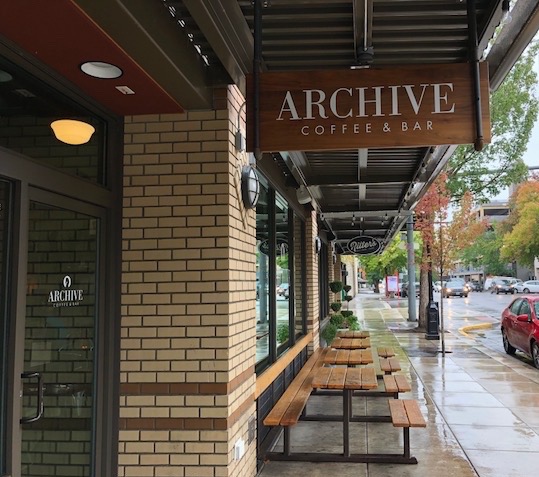Trendy coffee shops have sprung up around the Northwest almost as quickly and mysteriously as the hipsters did. Where did they come from? What do they want? And what, pray tell, are they going to do next?
Regardless of whether or not these haunting questions will ever be answered, there was one curious thing I noticed all these shops had in common: stacks of books. Some are intended to be read, while some are simply used as decoration. Many of these books have ancient covers, stacked intentionally to look unintentionally left behind. Some are placed conveniently for customers to read and pass the time away; some are placed so far out of reach no one can even read the titles.
What I wanted to know was what genre of books these coffee shops are choosing to shelve, whether there was a noticeable pattern, and whether or not we as publishers should start to look into this as a serious marketing strategy. This trend has already shown up in Penguin Random House’s decision to publish a series of classics with beautiful ‘vintage’ covers. We’ve all seen them. You know you want to spend next month’s rent on them. (Yes, they do cost that much.) They are, essentially, meant for coffee shop decor.
I decided to go on a hunt. I went to five popular coffee shops in downtown Salem: Broadway, IKE Box, The Gov Cup, The Beanery, and Archive. Only three of these shops had actual books as opposed to just newspapers. Of these three, I looked for what books they shelved, where they were placed, and what their intended function seemed to be.
Broadway Coffee House
Broadway is located just north of downtown Salem and is owned and operated by Salem Alliance. I went in expecting to find religious texts stacked in some corner. What I found, however, was a small stack of classics atop a fireplace—almost completely out of reach. The shop was busy at the time of my examination, so I’m sure there were more than a few looks at the strange girl standing on her tip-toes to grab a piece of what was obviously decoration from the mantle of the unused fireplace. The stack included an anthology of Shakespeare’s plays, The Jungle Book, a volume of mysteries, and an ‘old’ copy of The Unredeemed Captive. These novels were clearly not for readers passing through.
IKE Box
The next stop was the IKE Box, a nonprofit coffee house located close to the YMCA, just on the fringes of the main downtown area. Upon walking in, I did not immediately see any books lying around. After asking at the counter, however, the manager led me up a set up stairs behind the barista area to the second floor, where they keep their rooms for large meetings and conferences and general volunteer hang-outs. He pointed me to a shelf of books they kept for those who passed the time up there. The shelf consisted of self-help, spiritual, and children’s titles. None had that typical worn look used in decor. These were obviously intended for people to read.
Archive
My final stop was my personal favorite, a place that I knew had a plethora of material, located in the very heart of downtown Salem. Archive is decorated to look like just that: an archive of knowledge. Massive shelves stretch to tall ceilings on either side of the shop, stacked with sets of old encyclopedias. Tables line these walls as well, and I have on more than one occasion pulled down a book or two from right beside me to read. My favorite is a collection of National Geographic magazines from the early 1900s, all compiled neatly between worn gray spines with red lettering on the cover.
The books found at Archive, then, could really function for either side of the equation: nerds like me could read them, or they could sit unnoticed, a thing of quiet beauty.
At each location, the books served a different function. I feel it is important to take note, however, that books were still being bought and used, regardless of whether or not they were being read. For Broadway, the books are what I like to refer to as DCs: dust collectors. Both Archive and Broadway used old, worn-out editions. All three locations had books with interesting content: Broadway took a pop-culture approach, IKE Box had novels meant for their specific clientele, while Archive went for a nonfiction route, using titles that both served the intention of the shop while garnering interest of customers who greatly enjoyed reading. Archive’s titles ranged from all the way back to the 1800s to more modern novels published with an older-style cover.
Should we then, as publishers, be paying more attention to coffee shops as a means of marketing? Would more upper-class shops be willing to display, or even review, some of our titles? Or is it inevitable that those owners will continue to sneak into Goodwill, bargain shopping for books that are worn, falling apart, and unwanted? Is it even worth putting our books in places that were intended to be ignored?
In a fast-paced, ever-changing market, perhaps it is time we start seeing the places that have so far been unseen.

